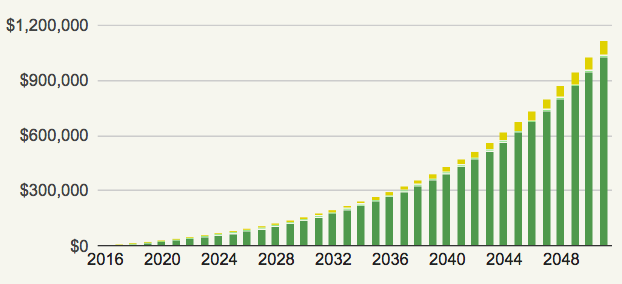Contrary to what Hollywood would have you believe, trading stocks isn’t a matter of putting on your favorite power suit, picking up a phone, and screaming “SELL! SELL! SELL!”

Pictured: Complete BS
Instead of trying to buy and sell hot stocks in the hopes of striking it rich, I suggest you reframe: Investing is a long-term strategy to help ensure your financial future.
In fact, it’s the single most crucial thing you can do today to make sure you’re ready for retirement and other savings goals. The sooner you start, the easier it is to get rich.
But I get it. We’ve been led to believe a lot of different things about stocks. Some of them are positive (“you can get rich by trading stocks!”), some of them not so much (“stocks are risky, ESPECIALLY with the recession/depression/financial-crisis-of-the-week just around the corner!”).
Luckily, most all of that noise is just that. There’s more than 100 years of evidence in the stock market that suggests that by investing in the stock market, you’ll be able to grow your wealth consistently over time.
To do that, though, you need to understand the basics of stocks — and how to trade them.
What is a stock?
Stocks are investments in a business. When you own a stock, you own part of the company that stock came from.
For that reason, stocks are also referred to as “equity,” since you own a small part of the company.
Stocks fluctuate in price depending on how the company is doing. For example, if Company A just released an amazing new product that is selling like crazy, the prices for Company A stocks are going to rise.
Alternately, if Company A experiences falling sales, their stocks are likely going to fall as well.
Advantages: If your stock is good and the company is flourishing, you can really make a lot of money. The money is also liquid. This means that you can get it at any time by selling your stock.
Disadvantages: If a company does poorly, so does your stock. Because a stock isn’t diversified, that can mean disaster for you (although you can easily reduce your risk by picking bigger, solid companies). Also, it’s important to note it’s nearly impossible to game the market — so it’s not worth trying for the lay investor.
Those are the basics of what stocks are. Now let’s take a look at how you can actually trade stocks.
NOTE: You should only be trading stocks once you have the rest of your financial house in order. That means automating your personal finance system, maxing out your 401k and Roth IRA, and building an emergency fund. Once you’ve done that, it’s totally fine to invest 5% of your income into stocks.
What is stock trading?
“Trading” stock is a bit of a misnomer. All it really refers to is the buying and selling of stock for money. So whenever you purchase or sell your equity, that’s considered trading.
And there are two ways you can trade stocks:
- Exchange floor trading. This is the kind of trading you see on movies and television with all the people shouting on the floor of the New York Stock Exchange. It’s a bit of a complex process, but at its core, here’s how it works: You tell your broker to purchase stock from a company, the broker sends a clerk to the floor to find a trader willing to sell you the shares, they agree on a price, and you get the shares.
- Electronic trading. This is a much more intuitive process for individual investors. It most often comes in the way of online brokerage platforms that allow you to immediately issue a trade during trading hours. No more relying on screaming floor traders to pick up shares for you.
For our intents and purposes, we’re going to be focused on electronic trading. That’s how I trade stocks and that’s how the vast majority of individual investors should be doing it as well. It’s simple, it’s intuitive, and you can get started in a few easy steps — which brings us to …
How to trade stocks
Inevitably, whenever I’m teaching someone about the basics of stocks, someone will pipe up with myriad questions like:
- “What stocks should I buy?”
- “Is X company a good investment?”
- “Is $XX too much for this stock?”
First thing’s first: SLOW DOWN.
Before you make an investment in any sort of stock, you’re going to want to stop and make sure you understand how to go about making a decision of what stock to buy — which brings us to:
Step 1: Set an investing goal
Before you even think to start investing, you should set some goals.
This is a crucial step psychologically and will help you stay focused on achieving your goals.
A good way to come up with an investing goal is to ask yourself why you’re investing. Do you want to save money for retirement? Are you trying to earn money for a big purchase down the road? Do you simply want to support whatever company/business you’re investing in?
Once you have your why, I suggest framing a SMART goal around it.
SMART goals are the solution to vague goal setting that gets you nowhere.
SMART stands for specific, measurable, attainable, relevant, and time-oriented. Here are a set of questions you can ask yourself to frame out your goal:
- Specific. What will my goal achieve? What is the precise outcome I’m looking for?
- Measurable. How will I know when I’ve accomplished the goal? What does success look like?
- Attainable. Are there resources I need to achieve the goal? What are those resources (e.g., gym membership, bank account, new clothes, etc.)?
- Relevant. Why am I doing this? Do I really WANT to do this? Is it a priority in my life right now?
- Time-oriented. What is the deadline? Will I know in a few weeks if I’m on the right track?
When it comes to your stock trading goals, you can have a goal as simple as “I want to earn $1,000 from my investments in two years to put towards a new car” or one that’s a little more complicated like, “I want to earn 30% more on my principal investment in one year.” See how you can set a SMART goal for your investments.
Step 2: Open a brokerage account
An online brokerage account is going to be where you’ll do your trading and investing — and there are a LOT to choose from.
My suggestion: Get a self-serve site such as E*Trade or TD Ameritrade. They’ll offer you an intuitive platform to get you started trading stocks.
Signing up is easy too. Follow the steps below to open one up today.
That’s right. It’s steps within steps! STEPCEPTION.
NOTE: Make sure you have your social security number, employer address, and bank info (account number and routing number) available when you sign up, as they’ll come in handy during the application process.
- Step 1: Go to the website for the brokerage of your choice.
- Step 2: Click on the “Open an account” button.
- Step 3: Start an application for an “Individual brokerage account.”
- Step 4: Enter information about yourself — name, address, birth date, employer info, social security.
- Step 5: Set up an initial deposit by entering your bank information. Some brokers require you to make a minimum deposit so use a separate bank account in order to deposit money into the brokerage account.
- Step 6: Wait. The initial transfer will take anywhere from 3 to 7 days to complete. After that, you’ll get a notification via email or phone call telling you you’re ready to invest.
- Step 7: Log into your brokerage account and start investing!
The application process can be as quick as 15 minutes and will put you on your path to a Rich Life.
Step 3: Buy your first stock
The simplest way to narrow down the universe of stock options is to think of companies you like and use.
Take some time right now to write down 15 companies you use and return to time after time.
Think of everything. For example:
- Food: Whole Foods, Conagra, Shake Shack
- Clothing: Under Armour, Limited Brands, Etsy
- Services: IBM, UPS
- Technology: Apple, Microsoft, Snap
- Entertainment: Disney, Live Nation, Netflix
- Transportation: Tesla, Ford, CSX Corporation
Instead of 5,000 stock options to choose from, you now have 15 companies you could possibly invest in.
Keep in mind that a good company doesn’t necessarily mean a good stock!
For any stock, you’re going to need a deeper analysis than “I think cars from Tesla are dope so I’m going to buy a bunch of stock from them.”
Instead, you’re going to want to look at five different areas:
- Trends: Are sales increasing from this time last year? 2 years ago? 5 years ago?
- Products: Is the future bright in terms of upcoming product development? What news have you heard about their future products?
- Revenues/profits/growth/earnings per share: The real financial nuts and bolts of a stock. These are intimidating at first. Luckily, many sites will guide you through it.
- Management: Is management good at the company? Or do they have bad press for unscrupulous practices like overworking their employees? What is the turnover? What is their philosophy and ability to execute?
Do as much research as you can. If you see a reason to doubt a company based on any of the areas above, avoid that stock.
At first all of the charts, earnings, and balance sheets will be incredibly confusing — but the more you look into them, the more you’ll start to get a good sense of what’s going on. It just takes practice.
Your investment future without bullshit
Remember what I said up top: Trading individual stocks is fine ONLY IF you have the rest of your financial house in order.
That means:
- Automating your personal finances
- Maxing out your 401k and Roth IRA contributions
- Building an emergency fund
- Getting out of debt
Only when you’ve done all those things is it fine to invest 5% to 10% of your income to individual stocks. That’s because you don’t get rich by investing in individual stocks. Instead, the best way to build a Rich Life is through low-cost, diversified index funds.
Let’s look at a real-world example.
Say you’re 25 years old and you decide to invest $500/month in a low-cost, diversified index fund. If you do that until you’re 60, how much money do you think you’d have?
Take a look:

$1,116,612.89.
That’s right. You’d be a millionaire after only investing a few thousand dollars per year.
Smart investments are about consistency more than chasing hot stocks or anything else:
If you are just starting out, it’s so awesome that you’re here.
For financial security, it’s more important than anything else to start early. That’s why my team created The Ultimate Guide to Personal Finance.
It’s a comprehensive guide that’ll introduce you to basic investing concepts that’ll best position you for a Rich Life. From mastering your 401k to automating your expenses, you’ll learn exactly what you need to do today to get the biggest financial wins.
Put your name and email below and I’ll send the guide straight to your inbox.
How to trade stocks in 3 steps is a post from: I Will Teach You To Be Rich.

